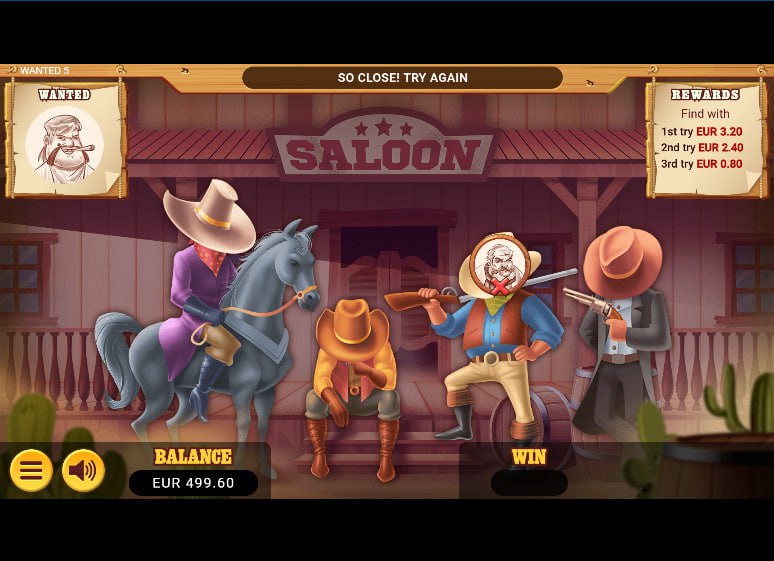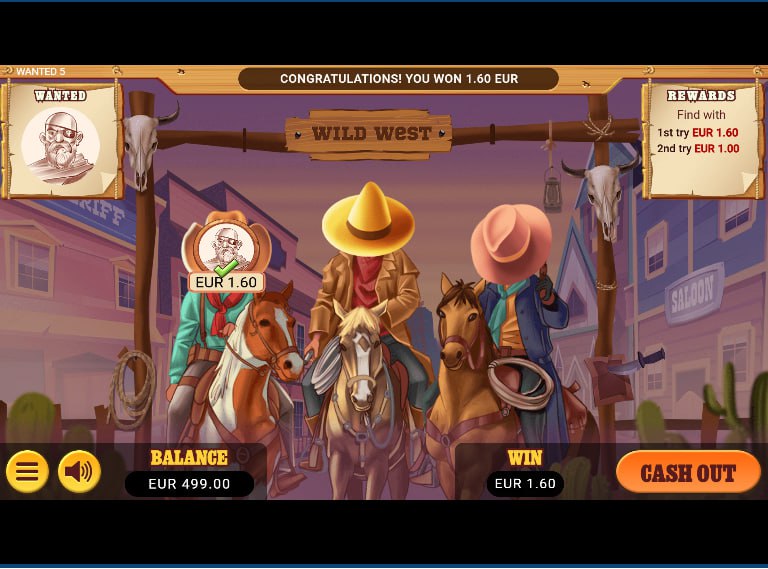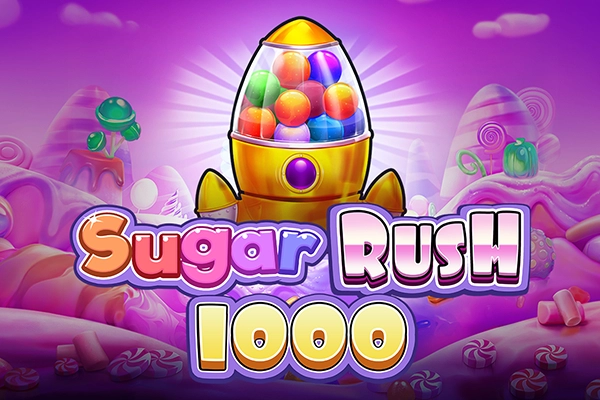Wanted 5 by Gamanza Games offers a significant departure from standard online slot gameplay. Set against a stylized Wild West theme, the game presents a clean, cartoonish atmosphere rather than a gritty depiction of outlaws. The core of the game discards reels and paylines for a multi-level ‘pick-and-click’ interface. Players advance by correctly identifying a hidden character from an escalating number of choices. The central mechanic is the constant decision to either cash out current winnings or risk them to proceed to the next, more difficult level. Successfully navigating five consecutive levels unlocks the main Bonus Feature: a final prize wheel. This design creates a tense game of deduction and risk management, all operating with a stated RTP of 96.67%. The entire experience hinges on this “press your luck” structure, offering a transparent challenge of nerve.
Gamanza Games' “Wanted 5” positions itself in the broad category of online casino entertainment, yet it fundamentally deviates from the conventional mechanics of a video slot. Instead of reels, paylines, and symbol combinations, it presents a structured, multi-level game of chance built around a singular, repeating challenge: identifying a target from a lineup. The core of the experience is a persistent tension between securing a current win or risking it for a greater reward in the next stage. This design choice strips away the familiar layers of slot gameplay, focusing entirely on a direct, escalating test of nerve. The game wraps this concept in a stylized Wild West theme, but the true focal point is its tiered progression and the critical “Cash Out” decision that defines every moment of play.
The game's structure is a compelling departure from the norm. It isn’t about waiting for a random bonus trigger; the player is in a constant state of deciding whether to advance. This framework creates a gameplay loop that feels more akin to a high-stakes TV game show than a traditional slot machine. Its appeal hinges on a player's appetite for this specific brand of escalating risk, offering a transparent, if unforgiving, path to its highest rewards.

The Core Gameplay Loop: A Test of Nerve and Luck
The central objective in Wanted 5 is straightforward: a “Wanted” poster reveals the face of an outlaw, and the player must deduce which hiding spot conceals them. The game unfolds across a series of levels, each increasing the number of potential suspects and, consequently, the difficulty. Level 2 presents two choices, Level 3 has three, Level 4 has four, and Level 5 culminates with five possible hiding spots. A correct guess allows the player to collect the winnings for that level and face a critical decision.
This decision point is the mechanical heart of Wanted 5. After each successful round, the player is presented with two options: Cash Out or continue to the next, more difficult level. Choosing to cash out immediately banks the accumulated winnings from that round, ending the game sequence. Choosing to proceed carries the entire accumulated sum forward, risking it all for the chance at a higher multiplier on the next level. A single incorrect guess at any stage results in the forfeiture of all winnings accrued in that game sequence, sending the player back to the start. This binary choice creates a palpable sense of risk management. The pressure mounts with each successful level, as the potential loss becomes more significant, forcing a constant re-evaluation of one's risk tolerance.
This design feels deliberate, targeting a player psyche that thrives on “press your luck” scenarios. It moves the engagement away from passive observation of spinning reels to active, albeit simple, decision-making. The consequence of failure is immediate and absolute within the round, which makes each choice to continue a calculated gamble. The game effectively distills the thrill of gambling into this single, repeating choice.
A Detailed Breakdown of Multipliers and Level Structure
The financial incentive to progress through the levels is driven by a system of escalating multipliers. These are not arbitrary; they are directly tied to the player's performance within each level. The fewer guesses it takes to find the correct suspect, the higher the multiplier applied to the initial bet for that stage. This adds a layer of variance beyond simply making a correct choice. A lucky first guess is substantially more valuable than a last-ditch success.
The Climactic Bonus Features
Successfully navigating the gauntlet of the first five levels without cashing out grants access to the game's ultimate objective: the Level 6 – Wheel Bonus Game. This feature represents the final reward for sustained risk. It is not another guessing game but a classic bonus wheel, which determines the final multiplier applied to the total winnings carried into the level. The wheel is segmented with different values: 0x, 0.5x, 1x, 1.5x, and 2x.
The inclusion of a 0x segment is a particularly brutal but effective design choice. It means that even after successfully completing five high-stakes guessing rounds, a player can still lose everything on the final spin of a wheel. This elevates the tension of the final stage to its peak. Conversely, landing on the 2x segment doubles the entire accumulated pot, representing the game's pinnacle achievement. This wheel is the culmination of the entire gameplay loop, a final, dramatic test of luck after a series of calculated risks.
Separate from the main game progression is a feature labeled Weekly Bonus Games. According to the game's introductory screen, this provides a chance to multiply winnings by up to 3x at the end of the game. The exact mechanics of this feature are less transparent, but it appears to function as a potential meta-reward, adding an extra layer of incentive that exists outside the immediate success or failure of a single round.

Art Direction and Thematic Execution
While the mechanics are the main attraction, Wanted 5 is presented with a cohesive and clean visual style. Gamanza Games opted for a cartoonish, cell-shaded aesthetic rather than a gritty, realistic depiction of the Wild West. This choice gives the game a more lighthearted and accessible feel, preventing the high-stakes gameplay from becoming overly intense. The characters are expressive, from the determined-looking female bounty hunter on her horse to the comical figure cowering behind a barrel. These designs add personality to what is otherwise a mechanically sparse game.
The animations are simple but effective. When a choice is made, the chosen character reveals whether they are the wanted outlaw. A correct guess is met with a clear confirmation, while an incorrect one triggers a “So Close! Try Again” message, swiftly ending the round. The user interface elements are thematically appropriate, with wooden textures on buttons and game screens designed to look like parchment or old saloon signs. The overall presentation is polished and uncluttered, ensuring that the player's focus remains squarely on the central guessing game and the all-important “Cash Out” button. The sound design complements the visuals with classic Western-style audio cues, reinforcing the atmosphere without being distracting.
In Wanted 5, Gamanza Games has crafted an experience that will likely polarize the slot-playing community. It’s an exercise in pure, transparent risk that will resonate strongly with a certain type of player. Those who are fatigued by the standard five-reel format and seek games where their choices, however simple, have immediate and significant consequences will find the structure here refreshing. The direct control over cashing out or continuing provides a sense of agency that is often absent in games based entirely on random number generation over multiple paylines.
Conversely, players who appreciate the complexity of modern video slots—with their intricate bonus rounds, free spins, varying symbol values, and cascading mechanics—may find the gameplay here to be one-dimensional. The reliance on a single, repetitive guessing mechanic lacks the layered discovery process of a feature-rich slot. With a stated Return to Player (RTP) of 96.67%, the game offers a competitive statistical foundation. However, its appeal is less about its mathematical profile and more about its psychological one. It is a well-executed instant-win-style game that successfully masquerades as a multi-stage adventure, designed for players who prefer the stark clarity of a high-stakes choice over the orchestrated chaos of spinning reels.













